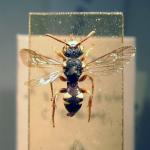Nomada errans var. korleviciana FRIESE 1921; Nomada errans var. sibirica FRIESE; Nomada transsylvatica ZILAHI-KISS 1927
This small Nomada was only recognised as British in 1944 (Spooner 1946) but had been found much earlier, in 1878, by C.W. Dale, although he failed to recognise the species. It is one of our most localised bee species, but has not been seen since 1982, despite several recent searches.
Restricted to a small area of coast on the Isle of Purbeck, Dorset. Widespread in southern Europe, but nowhere frequent.
This species is listed as Endangered (RDB1) in both Shirt (1987) and Falk (1991). It is probably extinct now in Britain
The known area is limestone grassland with local areas of open clay soil where the host bee, Andrena nitidiuscula, nests.
Univoltine, July and August.
The species has been found at wild carrot (Daucus carota), ragwort (Senecio sp.) and yarrow (Achillea sp.). It has also been found on Wild parsnip (Pastinaca sativa) in Germany (Westrich, 1989).
No information is available.
Profile written:
Updated: 22/12/2011


